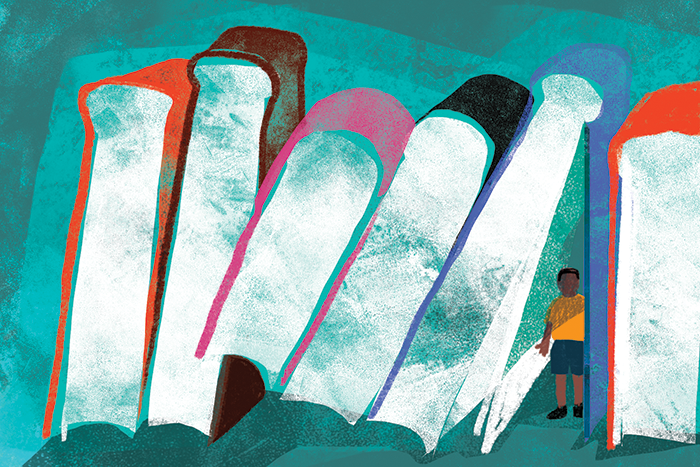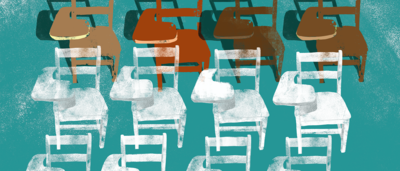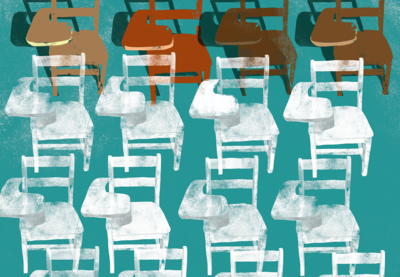Last September, in Louisiana, 9-year-old Ka’Mauri Harrison was taking a test in his bedroom—a reality for many students engaged in online learning during the coronavirus pandemic. His brother walked in, tripping over a BB gun in the background. Ka’Mauri picked it up and carried it toward the computer. His teacher kicked him off the video conference.
For briefly brandishing a BB gun in his own bedroom, Ka’Mauri faced nearly two weeks of suspension and a social worker was sent to his home.
“It is our policy that teachers and administrators may employ reasonable disciplinary and corrective measures,” a spokesperson for Jefferson Parish Schools said at the time, “to maintain order.”
Ka’Mauri is Black. So is Isaiah Elliott, a Colorado seventh grader who was suspended for holding a toy gun during art class. So is the 15-year-old girl who, in a now infamous case, was incarcerated in Michigan for not doing her homework and thus violating her parole.
The en masse switch to distance learning was unprecedented. But these outsized discipline measures against Black students, sadly, were not. Zoom suspensions followed similar patterns to in-person classroom management tactics that feed Black students into the school-to-prison pipeline.
“It’s a pathway that is sadly well-worn and very visible,” says Miriam Rollin, the director of the Education Civil Rights Alliance assembled by the National Center for Youth Law.
According to analysis of public data by ProPublica, Black students, nationally, are 3.9 times more likely to face suspension than white students. In some states, like Wisconsin (7.5 times), Minnesota (6.2 times) and Connecticut (6 times), it’s even more stark. And according to a 2018 analysis by the U.S. Government Accountability Office, Black students were overrepresented in every punishment measure evaluated, regardless of poverty level or school type.
The numbers’ severity and longevity underscore a systemic and seismic pushout of Black students, whose disproportionate contact with law enforcement leads to disproportionate rates of dropouts, disengagement and incarceration. Disrupting that cycle of punishment will be necessary to end the school-to-prison pipeline and protect the students most disproportionately harmed by such policies—namely Black, Indigenous and Latinx youth.
But experts in school discipline say there is something more insidious and emblematic behind distance learning discipline measures. It hasn’t just been suspensions. In a moment when students needed grace and leniency amidst brand-new challenges, a reliance on compliance emerged again and again. Students had to keep cameras on in their homes. Students got in trouble for missing school days or assignments as they were forced to work or care for siblings. Schools enforced dress codes and codes of conduct most Zoom-bound adults could not follow. All designed, as the Louisiana spokesperson put it, to maintain order.
Experts say these stories underscore the limitations of fixing disproportionate discipline outcomes strictly in terms of removing school police or eliminating the school-to-prison pipeline. The U.S. school system is dependent on control and compliance—and historically this dependence reaffirms and is inextricably bound up with tenets of white supremacy. Whether advocates call for reform measures or for a more systemic abolition of all school practices that resemble the carceral state, it’s clear that they agree on one thing: Equity requires understanding and excavating those white supremacist roots.
All systems create what they were designed to create. Sadly, the education system has been designed to weed out, to discriminate and to provide success for kids of privilege.
— Miriam Rollin
Compliance at the Root
Dr. David Stovall, a professor of Black studies, criminology, law and justice at the University of Illinois at Chicago, draws a distinction between schooling and education. “Schooling in its traditional sense is not necessarily about learning as much as it is about order and compliance,” he explains. “And [historically marginalized students] are the ones who will be compelled to adhere to this order and compliance because schools have always reflected a desire to control them.”
This function of schooling echoes in the history of assimilation schools, where Indigenous children were forced to abandon their homes, languages, hair and customs. It echoes in the history of policies that have increasingly regulated Black students’ hair, dress, behavior and speech.
Stovall pushes people to think beyond the school-to-prison pipeline and consider what he and others call the school-prison nexus. The pipeline, he says, is an argument that schools put students on a pathway to prison based on dehumanizing actions, including arcane discipline policies.
“What those of us who are arguing about a school-prison nexus are saying is that we have to pay attention to the fact that the logics of those schools and the logics of those prisons are almost identical, especially when we talk about discipline,” Stovall says. He draws direct connections between hallway protocols, restrictive bathroom policies, surveillance cameras and metal detectors that exist in both spaces.
“It’s something a little more insidious” than the school-to-prison pipeline, Stovall explains. “[Students] are reminded based on the discipline and curriculum policies that they’re in a de facto prison in those spaces.”
Stovall links the continued use of punitive policies and whitewashed curricula to a history of racism in schools. He says we know that more inclusive and less punitive environments lead to better learning outcomes.
“But under white supremacy,” he says, “the argument is that [a more inclusive approach] works for the wrong people.”
One definition of white supremacy that gets at its many systemic tendrils, including in schools, comes from Dr. Frances Ansley, who has described it as “a political, economic and cultural system in which whites overwhelmingly control power and material resources, conscious and unconscious ideas of white superiority and entitlement are widespread, and relations of white dominance and non-white subordination are daily reenacted across a broad array of institutions and social settings.”

In schools, this concentration of power and resource control might look like the overwhelmingly white stakeholders who create curricula, decide state standards, determine school funding and, yes, teach. Superiority and entitlement might look like codes of conduct and curricula filtered through a Eurocentric lens. Dominance and non-white subordination often play out in the enforcement of policies; this includes the obvious (disproportionate punishment) and the more subtle (tracking for AP classes).
“All systems create what they were designed to create,” Miriam Rollin says. “Sadly, the education system has been designed to weed out, to discriminate and to provide success for kids of privilege.”
It’s a painful message sent loud and clear to Black students and their families. Dr. Charles Bell, a professor of criminal justice at Illinois State University, has devoted much of his research to speaking to Black students and caregivers about their perceptions of school discipline.
“[Black students’ and caregivers’] experiences suggest that school inherently functions as an anti-Black institution because they criminalize Black students’ behaviors in ways they do not criminalize white students’ behaviors,” Bell says.
Bell points to the resistance to integration from white caregivers, educators and schools, and the creation of the school-to-prison pipeline that followed shortly after the final court-ordered ends to segregation.
“So you just had a history in which Black students have never been fully accepted in any educational space,” Bell explains.
The truth is there are some of these policies that just make zero sense and have nothing to do with learning. It’s really just about compliance or oppression.
— Dr. Nataki Gregory
Bell says that students he interviewed often felt targeted based on the way they dressed, their hair (e.g., locs) and their culture. One student Bell interviewed was facing financial hardship and therefore didn’t have consistent access to laundry. When the student didn’t have clean, white-collared shirts to wear, he came to school out of dress code. He received a 30-day suspension.
It’s an all-too-common occurrence—and one that didn’t end during distance learning.
“What we’re finding is it is just a continuation of bad practices from in-person spaces that has moved into the virtual,” says Dr. Nataki Gregory, the CEO of CT3, an organization that provides training focused on relationship building and student engagement in service of high student achievement.
Gregory says policies must be connected to learning and equitable outcomes. She instructs school leaders to consider who a policy benefits and for whom it might be harmful.
“Because the truth is there are some of these policies that just make zero sense and have nothing to do with learning,” she says. “It’s really just about compliance or oppression. And if that’s what you’re trying to bring into the school, then you have the wrong focus.”
And that focus—endemic in schools across the United States—is doing active harm.
The Harm Caused by Compliance
Over the years, Bell says he’s seen two competing, but interconnected, narratives. He has witnessed Black parents removing students from predominately Black schools where they felt punishment tactics were putting their kids “on a pathway to prison.” And he has witnessed Black parents removing students from predominately white schools, which they saw as anti-Black.
“What that does,” Bell says, “is it creates a dynamic of, ‘I’m not safe anywhere.’”
That lack of safety is tangible and has lasting effects. The educational harm is obvious. Bell’s interviews supported what we know empirically: Suspensions, time out of the classroom and school climates wherein certain students feel unwelcome or undervalued hurt those students’ grades and engagement. Students become more likely to tune out and drop out.
Gregory says this educational harm contradicts the stated mission of schools: to center learning and development. And for some students, punitive policies become an escape valve. In settings that frequently dehumanize or humiliate them, students may act out to get kicked out.
“If the goal is to get students to engage more, do more, achieve more, and ‘discipline’ doesn’t get them more excited about doing that, then the discipline is ineffective,” Gregory says. “Because then the discipline is just punishment. And if punishment is your goal, then you’re never going to get to a place where students attend to their work, to your leadership, to your teaching in a way you want. Because now I feel like this is the place I come to be punished. And punishment is always a threat that’s looming over my head.”
For Dr. Thalia González, the effects of that looming threat are key to reshaping the way advocates talk about school discipline practices. A nationally renowned expert in restorative justice, González says much of the discourse surrounding discipline focuses solely on the fact that, over time, Black students are more likely to face punishment and pushout. But she says that ignores, in some ways, the real-time disproportionate health effects.
“It’s a public health issue at its core,” González says. She notes that data show high school graduation can increase life span by as much as 15 years. She points to research that illustrates how removal from school and classroom environments causes symptoms in children that look a lot like post-traumatic stress disorder.
“In adolescence and early childhood, there are buffers against negative effects of trauma, including peer connectedness and school connectedness,” González says. “And when you remove someone from a classroom environment or a learning environment or a school community, you tear that apart.”
Bell has also seen this firsthand in his work. “I’ve seen some students internalize school rejection or being targeted,” he says, “to the point where I had a few students who told me that they were considering suicide as a result of this continuous targeting and rejection from educators.”
Focusing on health outcomes, González stresses, does not mean ignoring the ways in which racism, white supremacy and social control lead to punitive discipline policies. But it stresses the urgency and stakes for demanding change.
“It’s about saying, ‘How do we make this change, and how do we disrupt these drivers for young people that will continue to persist if we can’t get rid of—or at least purge to a large extent—this whole structure that is about social control of a particular set of bodies?’”
An Urgent Need For Change
Across the country, schools will have to take a systematic approach to undoing structures that rely on compliance and punitive discipline.
“Our system is failing kids,” Rollin says, “and we need to hold that system accountable.”
In an ideal world, advocates say, transformation happens from the bottom up: Educators take the steps they can take today to interrupt their own harmful practices. And going forward, coalitions of students, educators and families shape more culturally sustaining school communities. School policies encode a more restorative approach. State policies and codes are amended to incentivize a severe reduction in suspensions and policies imbued with racism, such as dress codes or modes of compliance. And if all of that hits a roadblock, Rollin says, it may be time for a lawsuit.
But while long-term solutions must be found systematically and deliberately, educators and students face urgent need—and immediate consequences. Whether learning at a distance or in person, the harm perpetuated by punitive policies is happening to students right now.
Before a Colorado school suspended Isaiah Elliott for holding a toy gun, they sent a police officer to his home. “You put his life in jeopardy,” his mother said to the school—a school that had followed its systems and policies exactly as designed.

The Foundations of Restorative Justice
School discipline and classroom management do not have to be based in compliance. Learn more about restorative practices in this companion piece to the feature article “It Was Always About Control.”

